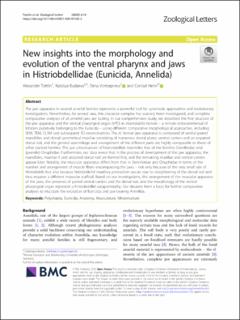| dc.description.abstract | The jaw apparatus in several annelid families represents a powerful tool for systematic approaches and evolutionary investigations. Nevertheless, for several taxa, this character complex has scarcely been investigated, and complete comparative analyses of all annelid jaws are lacking. In our comprehensive study, we described the fine structure of the jaw apparatus and the ventral pharyngeal organ (VPO) in Histriobdella homari – a minute ectocommensal of lobsters putatively belonging to the Eunicida – using different comparative morphological approaches, including SEM, TEM, CLSM and subsequent 3D reconstruction. The H. homari jaw apparatus is composed of ventral paired mandibles and dorsal symmetrical maxillae consisting of numerous dental plates, ventral carriers and an unpaired dorsal rod, and the general assemblage and arrangement of the different parts are highly comparable to those of other eunicid families. The jaw ultrastructure of histriobdellids resembles that of the families Dorvilleidae and (juvenile) Onuphidae. Furthermore, our data reveal that in the process of development of the jaw apparatus, the mandibles, maxillae II and unpaired dorsal rod are formed first, and the remaining maxillae and ventral carriers appear later. Notably, the muscular apparatus differs from that in Dorvilleidae and Onuphidae in terms of the number and arrangement of muscle fibers encompassing the jaws – not only because of the very small size of Histriobdella but also because histriobdellid maxillary protraction occurs due to straightening of the dorsal rod and thus requires a different muscular scaffold. Based on our investigations, the arrangement of the muscular apparatus of the jaws, the presence of paired ventral carriers and the dorsal rod, and the morphology of the ventral pharyngeal organ represent a histriobdellid autapomorphy. Our datasets form a basis for further comparative analyses to elucidate the evolution of Eunicida and jaw-bearing Annelida. | en_US |

